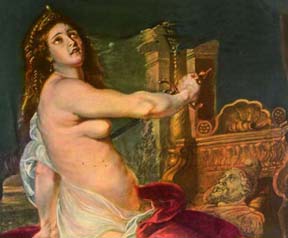|
Book III
|
Although we did not read Book III, it will help to
summarize a couple of the important things that happen,
because in the course of this book, Aeneas has to discover
where his destined home will be and what its character
is:
- Aeneas tries to found a city in Thrace (still
within the Greco-Trojan realm), but finds the land
hostile and polluted with blood.
- He is told by an oracle to return to his
motherland, which Anchises interprets as Crete.
- Enroute they stop at Buthrotum in Greece, where
Helenos (the Trojan seer) and his wife Andromache
(Hektor's widow) have built a miniature Troy; but their
attention is fixed on the past not the future (this
cannot be the character of Aeneas' future city).
- Aeneas tries to settle in Crete, but a plague
strikes his newly established community and he realizes
they must move on. Aeneas finally recognizes that Italy,
the home of Dardanus, is the motherland to which the
oracle directed him.
|
|
Book IV.1-3
|
Note the repetition of images of disorder/passion
(fire, wound) that gather around Dido in the first three
lines.
|
|
IV.76-126
|
- Again, watch fire and wound imagery; Dido's wound
is that of a deer struck by a hunter's arrow. It evokes
memory of Aeneas' hunting in Book I, but also of Venus
disguised as huntress
- Note also what happens to Carthage while Dido is
enflamed with passion.
- What quite different agendas might Juno and Venus
have had in encouraging the relationship between Aeneas
and Dido?
|
|
IV.181-238
|
- A storm is Juno's particular weapon of disorder in
this poem
- What does Dido think happened in the cave? (Note
the wedding imagery Juno assembled to make her think
so!)
|
|
IV.299-275
|
- Aeneas has lost sight of his destiny, and Jupiter
determines to recall him to it.
- in 312-15 we are reminded again of the dual nature
of the epic
- 360-64, again note as example of
pietas.
|
|
|
- Compare Dido's and Aeneas' reactions to his
imminent departure. The two forces that compel them
(passion and pietas) only increase in reaction to
one another. See especially 4.545 ff
- Are both drawn sufficiently sympathetically that
the tragedy would give a Roman pause over the lives and
cities that were destroyed in the path of Roman expansion
(e.g., Carthage)?
|
|
<<calendar
|
Thus the great future of Rome is preceded by
sympathetic telling of the tragedy that it produced, that of
Dido, which must have seemed to Virgil's audience
inseparable from that of Carthage, which had been crushed in
the wake of Roman expansion.
|

